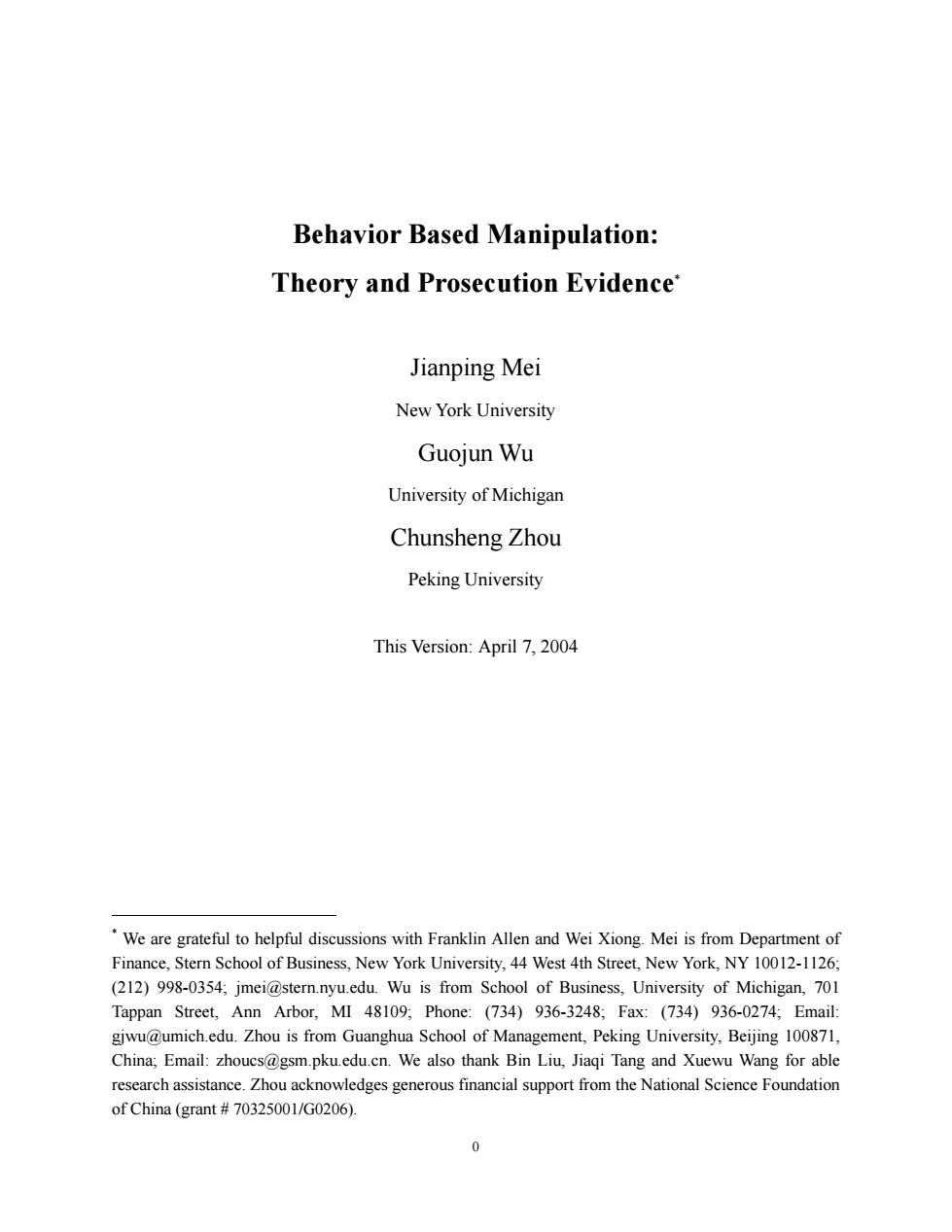
Behavior Based Manipulation: Theory and Prosecution Evidence' Jianping Mei New York University Guojun Wu University of Michigan Chunsheng Zhou Peking University This Version:April 7,2004 We are grateful to helpful discussions with Franklin Allen and Wei Xiong.Mei is from Department of Finance,Stern School of Business,New York University,44 West 4th Street,New York,NY 10012-1126; (212)998-0354;jmei@stern.nyu.edu.Wu is from School of Business,University of Michigan,701 Tappan Street,Ann Arbor,MI 48109;Phone:(734)936-3248;Fax:(734)936-0274;Email: gjwu@umich.edu.Zhou is from Guanghua School of Management,Peking University,Beijing 100871, China;Email:zhoucs@gsm.pku.edu.cn.We also thank Bin Liu,Jiagi Tang and Xuewu Wang for able research assistance.Zhou acknowledges generous financial support from the National Science Foundation of China(grant 70325001/G0206). 0
0 Behavior Based Manipulation: Theory and Prosecution Evidence* Jianping Mei New York University Guojun Wu University of Michigan Chunsheng Zhou Peking University This Version: April 7, 2004 * We are grateful to helpful discussions with Franklin Allen and Wei Xiong. Mei is from Department of Finance, Stern School of Business, New York University, 44 West 4th Street, New York, NY 10012-1126; (212) 998-0354; jmei@stern.nyu.edu. Wu is from School of Business, University of Michigan, 701 Tappan Street, Ann Arbor, MI 48109; Phone: (734) 936-3248; Fax: (734) 936-0274; Email: gjwu@umich.edu. Zhou is from Guanghua School of Management, Peking University, Beijing 100871, China; Email: zhoucs@gsm.pku.edu.cn. We also thank Bin Liu, Jiaqi Tang and Xuewu Wang for able research assistance. Zhou acknowledges generous financial support from the National Science Foundation of China (grant # 70325001/G0206)
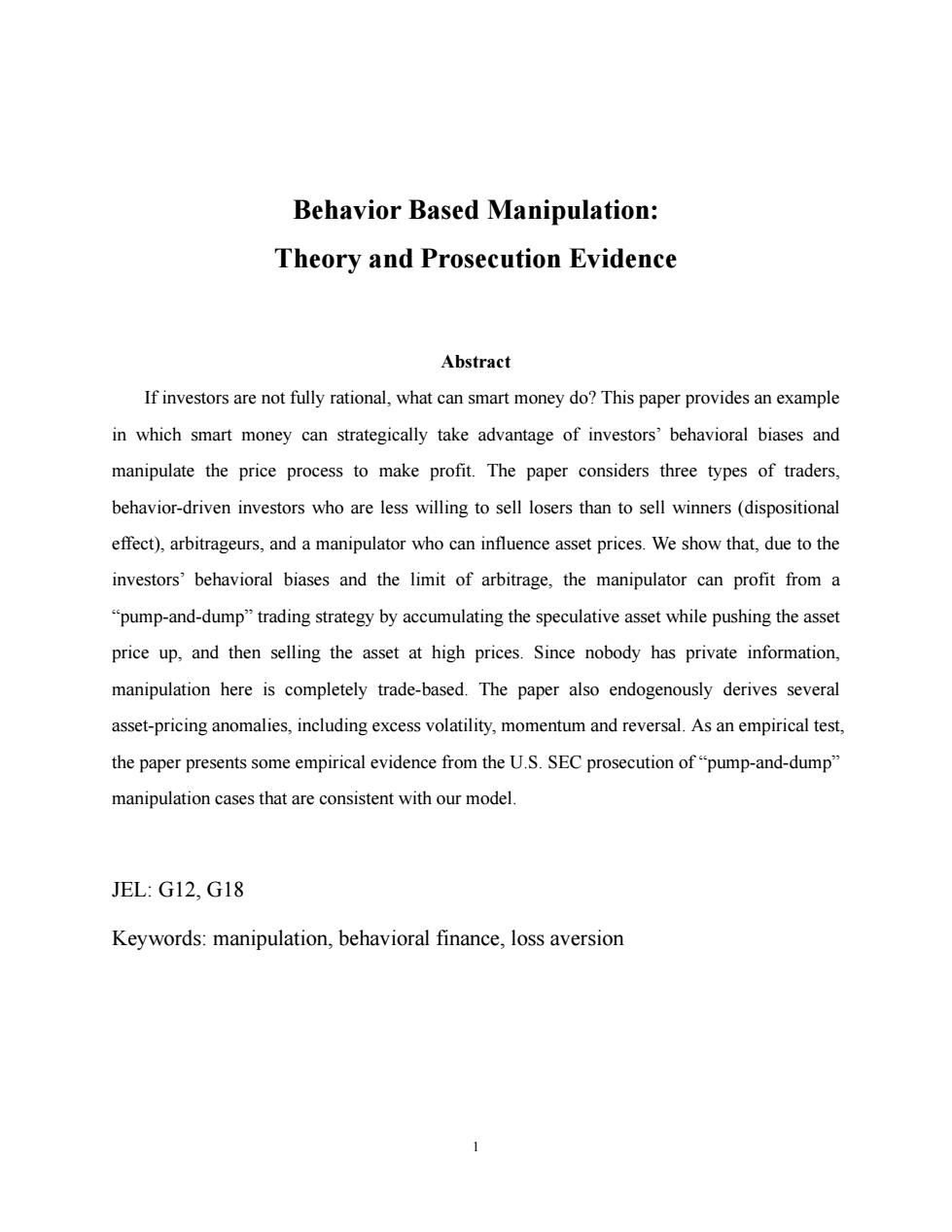
Behavior Based Manipulation: Theory and Prosecution Evidence Abstract If investors are not fully rational,what can smart money do?This paper provides an example in which smart money can strategically take advantage of investors'behavioral biases and manipulate the price process to make profit.The paper considers three types of traders, behavior-driven investors who are less willing to sell losers than to sell winners (dispositional effect),arbitrageurs,and a manipulator who can influence asset prices.We show that,due to the investors'behavioral biases and the limit of arbitrage,the manipulator can profit from a "pump-and-dump"trading strategy by accumulating the speculative asset while pushing the asset price up,and then selling the asset at high prices.Since nobody has private information, manipulation here is completely trade-based.The paper also endogenously derives several asset-pricing anomalies,including excess volatility,momentum and reversal.As an empirical test, the paper presents some empirical evidence from the U.S.SEC prosecution of"pump-and-dump" manipulation cases that are consistent with our model. JEL:G12,G18 Keywords:manipulation,behavioral finance,loss aversion
1 Behavior Based Manipulation: Theory and Prosecution Evidence Abstract If investors are not fully rational, what can smart money do? This paper provides an example in which smart money can strategically take advantage of investors’ behavioral biases and manipulate the price process to make profit. The paper considers three types of traders, behavior-driven investors who are less willing to sell losers than to sell winners (dispositional effect), arbitrageurs, and a manipulator who can influence asset prices. We show that, due to the investors’ behavioral biases and the limit of arbitrage, the manipulator can profit from a “pump-and-dump” trading strategy by accumulating the speculative asset while pushing the asset price up, and then selling the asset at high prices. Since nobody has private information, manipulation here is completely trade-based. The paper also endogenously derives several asset-pricing anomalies, including excess volatility, momentum and reversal. As an empirical test, the paper presents some empirical evidence from the U.S. SEC prosecution of “pump-and-dump” manipulation cases that are consistent with our model. JEL: G12, G18 Keywords: manipulation, behavioral finance, loss aversion
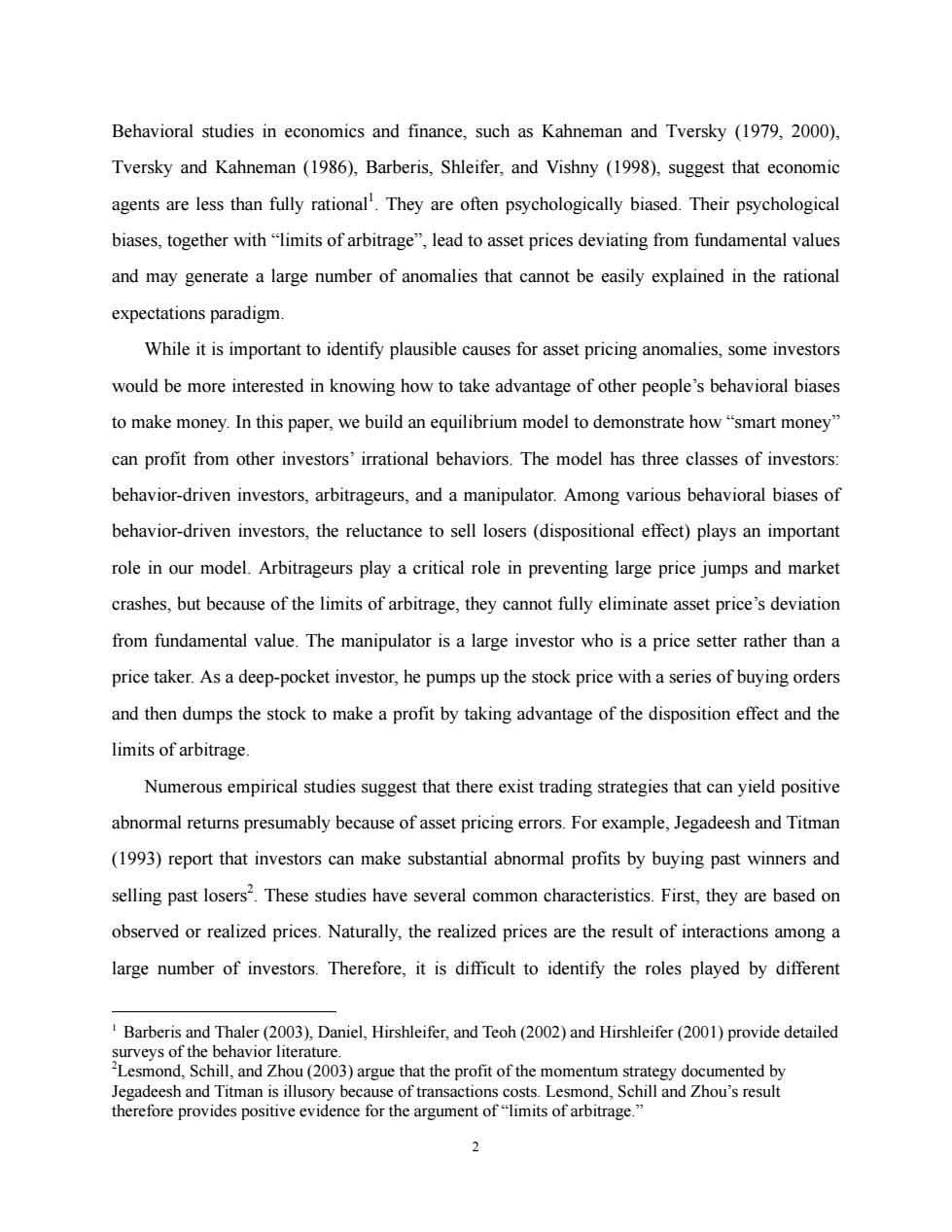
Behavioral studies in economics and finance,such as Kahneman and Tversky (1979,2000), Tversky and Kahneman (1986),Barberis,Shleifer,and Vishny (1998),suggest that economic agents are less than fully rational'.They are often psychologically biased.Their psychological biases,together with"limits of arbitrage",lead to asset prices deviating from fundamental values and may generate a large number of anomalies that cannot be easily explained in the rational expectations paradigm. While it is important to identify plausible causes for asset pricing anomalies,some investors would be more interested in knowing how to take advantage of other people's behavioral biases to make money.In this paper,we build an equilibrium model to demonstrate how "smart money" can profit from other investors'irrational behaviors.The model has three classes of investors: behavior-driven investors,arbitrageurs,and a manipulator.Among various behavioral biases of behavior-driven investors,the reluctance to sell losers (dispositional effect)plays an important role in our model.Arbitrageurs play a critical role in preventing large price jumps and market crashes,but because of the limits of arbitrage,they cannot fully eliminate asset price's deviation from fundamental value.The manipulator is a large investor who is a price setter rather than a price taker.As a deep-pocket investor,he pumps up the stock price with a series of buying orders and then dumps the stock to make a profit by taking advantage of the disposition effect and the limits of arbitrage Numerous empirical studies suggest that there exist trading strategies that can yield positive abnormal returns presumably because of asset pricing errors.For example,Jegadeesh and Titman (1993)report that investors can make substantial abnormal profits by buying past winners and selling past losers2.These studies have several common characteristics.First,they are based on observed or realized prices.Naturally,the realized prices are the result of interactions among a large number of investors.Therefore,it is difficult to identify the roles played by different Barberis and Thaler(2003),Daniel,Hirshleifer,and Teoh(2002)and Hirshleifer(2001)provide detailed surveys of the behavior literature. Lesmond,Schill,and Zhou(2003)argue that the profit of the momentum strategy documented by Jegadeesh and Titman is illusory because of transactions costs.Lesmond,Schill and Zhou's result therefore provides positive evidence for the argument of"limits of arbitrage." 2
2 Behavioral studies in economics and finance, such as Kahneman and Tversky (1979, 2000), Tversky and Kahneman (1986), Barberis, Shleifer, and Vishny (1998), suggest that economic agents are less than fully rational1 . They are often psychologically biased. Their psychological biases, together with “limits of arbitrage”, lead to asset prices deviating from fundamental values and may generate a large number of anomalies that cannot be easily explained in the rational expectations paradigm. While it is important to identify plausible causes for asset pricing anomalies, some investors would be more interested in knowing how to take advantage of other people’s behavioral biases to make money. In this paper, we build an equilibrium model to demonstrate how “smart money” can profit from other investors’ irrational behaviors. The model has three classes of investors: behavior-driven investors, arbitrageurs, and a manipulator. Among various behavioral biases of behavior-driven investors, the reluctance to sell losers (dispositional effect) plays an important role in our model. Arbitrageurs play a critical role in preventing large price jumps and market crashes, but because of the limits of arbitrage, they cannot fully eliminate asset price’s deviation from fundamental value. The manipulator is a large investor who is a price setter rather than a price taker. As a deep-pocket investor, he pumps up the stock price with a series of buying orders and then dumps the stock to make a profit by taking advantage of the disposition effect and the limits of arbitrage. Numerous empirical studies suggest that there exist trading strategies that can yield positive abnormal returns presumably because of asset pricing errors. For example, Jegadeesh and Titman (1993) report that investors can make substantial abnormal profits by buying past winners and selling past losers2 . These studies have several common characteristics. First, they are based on observed or realized prices. Naturally, the realized prices are the result of interactions among a large number of investors. Therefore, it is difficult to identify the roles played by different 1 Barberis and Thaler (2003), Daniel, Hirshleifer, and Teoh (2002) and Hirshleifer (2001) provide detailed surveys of the behavior literature. 2 Lesmond, Schill, and Zhou (2003) argue that the profit of the momentum strategy documented by Jegadeesh and Titman is illusory because of transactions costs. Lesmond, Schill and Zhou’s result therefore provides positive evidence for the argument of “limits of arbitrage
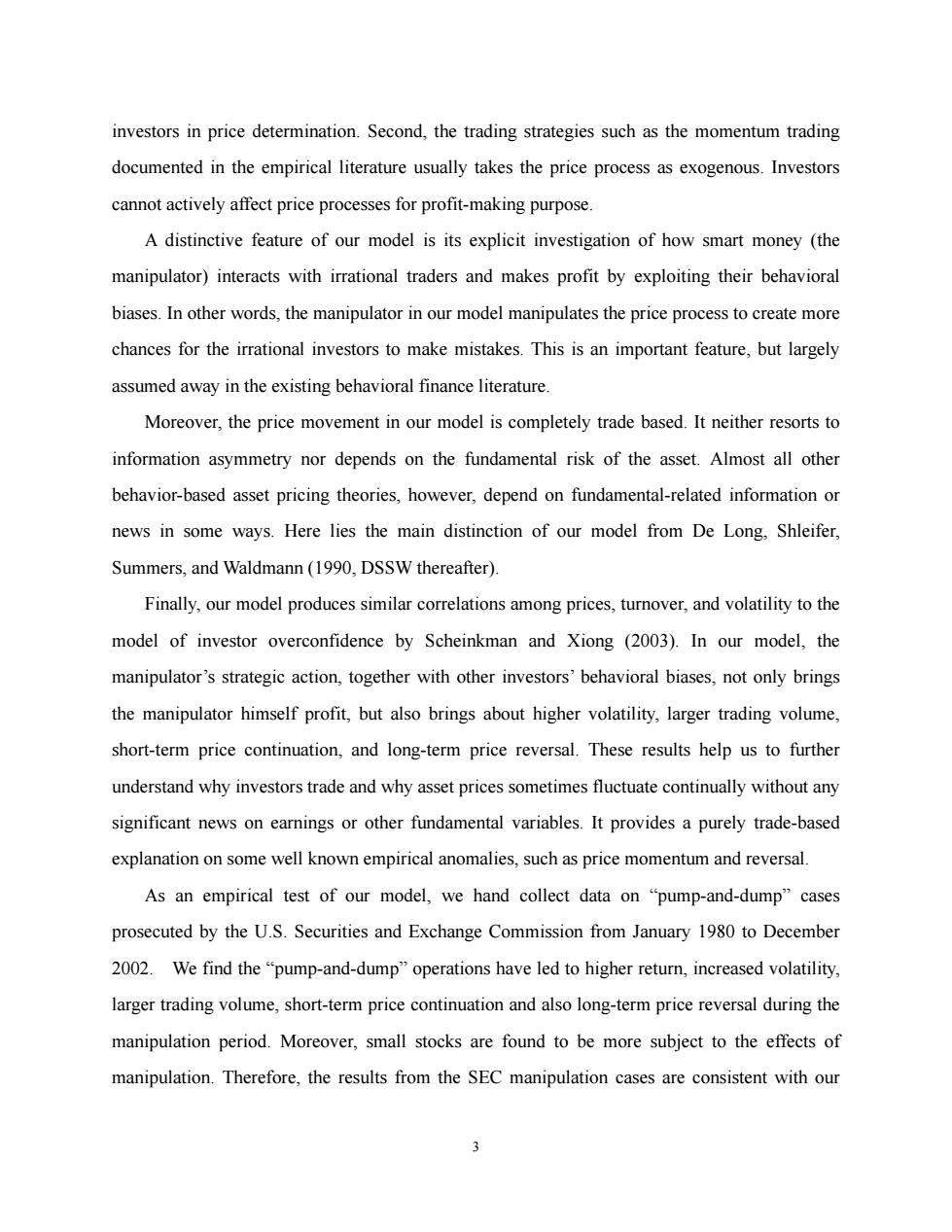
investors in price determination.Second,the trading strategies such as the momentum trading documented in the empirical literature usually takes the price process as exogenous.Investors cannot actively affect price processes for profit-making purpose. A distinctive feature of our model is its explicit investigation of how smart money (the manipulator)interacts with irrational traders and makes profit by exploiting their behavioral biases.In other words,the manipulator in our model manipulates the price process to create more chances for the irrational investors to make mistakes.This is an important feature,but largely assumed away in the existing behavioral finance literature. Moreover,the price movement in our model is completely trade based.It neither resorts to information asymmetry nor depends on the fundamental risk of the asset.Almost all other behavior-based asset pricing theories,however,depend on fundamental-related information or news in some ways.Here lies the main distinction of our model from De Long,Shleifer, Summers,and Waldmann(1990,DSSW thereafter). Finally,our model produces similar correlations among prices,turnover,and volatility to the model of investor overconfidence by Scheinkman and Xiong (2003).In our model,the manipulator's strategic action,together with other investors'behavioral biases,not only brings the manipulator himself profit,but also brings about higher volatility,larger trading volume, short-term price continuation,and long-term price reversal.These results help us to further understand why investors trade and why asset prices sometimes fluctuate continually without any significant news on earnings or other fundamental variables.It provides a purely trade-based explanation on some well known empirical anomalies,such as price momentum and reversal. As an empirical test of our model,we hand collect data on "pump-and-dump"cases prosecuted by the U.S.Securities and Exchange Commission from January 1980 to December 2002.We find the"pump-and-dump"operations have led to higher return,increased volatility, larger trading volume,short-term price continuation and also long-term price reversal during the manipulation period.Moreover,small stocks are found to be more subject to the effects of manipulation.Therefore,the results from the SEC manipulation cases are consistent with our 3
3 investors in price determination. Second, the trading strategies such as the momentum trading documented in the empirical literature usually takes the price process as exogenous. Investors cannot actively affect price processes for profit-making purpose. A distinctive feature of our model is its explicit investigation of how smart money (the manipulator) interacts with irrational traders and makes profit by exploiting their behavioral biases. In other words, the manipulator in our model manipulates the price process to create more chances for the irrational investors to make mistakes. This is an important feature, but largely assumed away in the existing behavioral finance literature. Moreover, the price movement in our model is completely trade based. It neither resorts to information asymmetry nor depends on the fundamental risk of the asset. Almost all other behavior-based asset pricing theories, however, depend on fundamental-related information or news in some ways. Here lies the main distinction of our model from De Long, Shleifer, Summers, and Waldmann (1990, DSSW thereafter). Finally, our model produces similar correlations among prices, turnover, and volatility to the model of investor overconfidence by Scheinkman and Xiong (2003). In our model, the manipulator’s strategic action, together with other investors’ behavioral biases, not only brings the manipulator himself profit, but also brings about higher volatility, larger trading volume, short-term price continuation, and long-term price reversal. These results help us to further understand why investors trade and why asset prices sometimes fluctuate continually without any significant news on earnings or other fundamental variables. It provides a purely trade-based explanation on some well known empirical anomalies, such as price momentum and reversal. As an empirical test of our model, we hand collect data on “pump-and-dump” cases prosecuted by the U.S. Securities and Exchange Commission from January 1980 to December 2002. We find the “pump-and-dump” operations have led to higher return, increased volatility, larger trading volume, short-term price continuation and also long-term price reversal during the manipulation period. Moreover, small stocks are found to be more subject to the effects of manipulation. Therefore, the results from the SEC manipulation cases are consistent with our
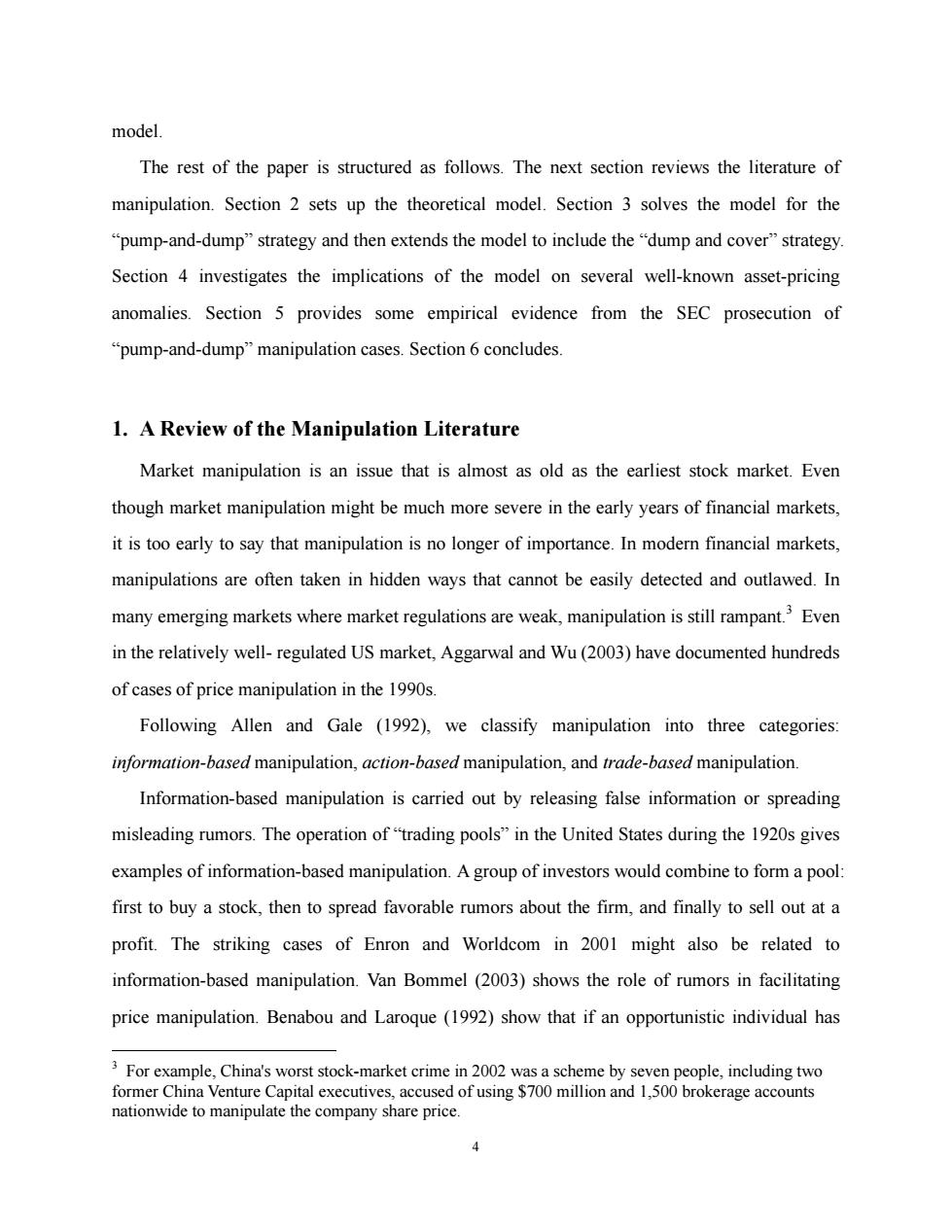
model. The rest of the paper is structured as follows.The next section reviews the literature of manipulation.Section 2 sets up the theoretical model.Section 3 solves the model for the “pump-and-dump”strategy and then extends the model to include the“dump and cover'”strategy. Section 4 investigates the implications of the model on several well-known asset-pricing anomalies.Section 5 provides some empirical evidence from the SEC prosecution of "pump-and-dump"manipulation cases.Section 6 concludes. 1.A Review of the Manipulation Literature Market manipulation is an issue that is almost as old as the earliest stock market.Even though market manipulation might be much more severe in the early years of financial markets, it is too early to say that manipulation is no longer of importance.In modern financial markets, manipulations are often taken in hidden ways that cannot be easily detected and outlawed.In many emerging markets where market regulations are weak,manipulation is still rampant.3 Even in the relatively well-regulated US market,Aggarwal and Wu(2003)have documented hundreds of cases of price manipulation in the 1990s. Following Allen and Gale (1992),we classify manipulation into three categories: information-based manipulation,action-based manipulation,and trade-based manipulation. Information-based manipulation is carried out by releasing false information or spreading misleading rumors.The operation of"trading pools"in the United States during the 1920s gives examples of information-based manipulation.A group of investors would combine to form a pool: first to buy a stock,then to spread favorable rumors about the firm,and finally to sell out at a profit.The striking cases of Enron and Worldcom in 2001 might also be related to information-based manipulation.Van Bommel (2003)shows the role of rumors in facilitating price manipulation.Benabou and Laroque (1992)show that if an opportunistic individual has 3 For example,China's worst stock-market crime in 2002 was a scheme by seven people,including two former China Venture Capital executives,accused of using $700 million and 1,500 brokerage accounts nationwide to manipulate the company share price
4 model. The rest of the paper is structured as follows. The next section reviews the literature of manipulation. Section 2 sets up the theoretical model. Section 3 solves the model for the “pump-and-dump” strategy and then extends the model to include the “dump and cover” strategy. Section 4 investigates the implications of the model on several well-known asset-pricing anomalies. Section 5 provides some empirical evidence from the SEC prosecution of “pump-and-dump” manipulation cases. Section 6 concludes. 1. A Review of the Manipulation Literature Market manipulation is an issue that is almost as old as the earliest stock market. Even though market manipulation might be much more severe in the early years of financial markets, it is too early to say that manipulation is no longer of importance. In modern financial markets, manipulations are often taken in hidden ways that cannot be easily detected and outlawed. In many emerging markets where market regulations are weak, manipulation is still rampant.3 Even in the relatively well- regulated US market, Aggarwal and Wu (2003) have documented hundreds of cases of price manipulation in the 1990s. Following Allen and Gale (1992), we classify manipulation into three categories: information-based manipulation, action-based manipulation, and trade-based manipulation. Information-based manipulation is carried out by releasing false information or spreading misleading rumors. The operation of “trading pools” in the United States during the 1920s gives examples of information-based manipulation. A group of investors would combine to form a pool: first to buy a stock, then to spread favorable rumors about the firm, and finally to sell out at a profit. The striking cases of Enron and Worldcom in 2001 might also be related to information-based manipulation. Van Bommel (2003) shows the role of rumors in facilitating price manipulation. Benabou and Laroque (1992) show that if an opportunistic individual has 3 For example, China's worst stock-market crime in 2002 was a scheme by seven people, including two former China Venture Capital executives, accused of using $700 million and 1,500 brokerage accounts nationwide to manipulate the company share price
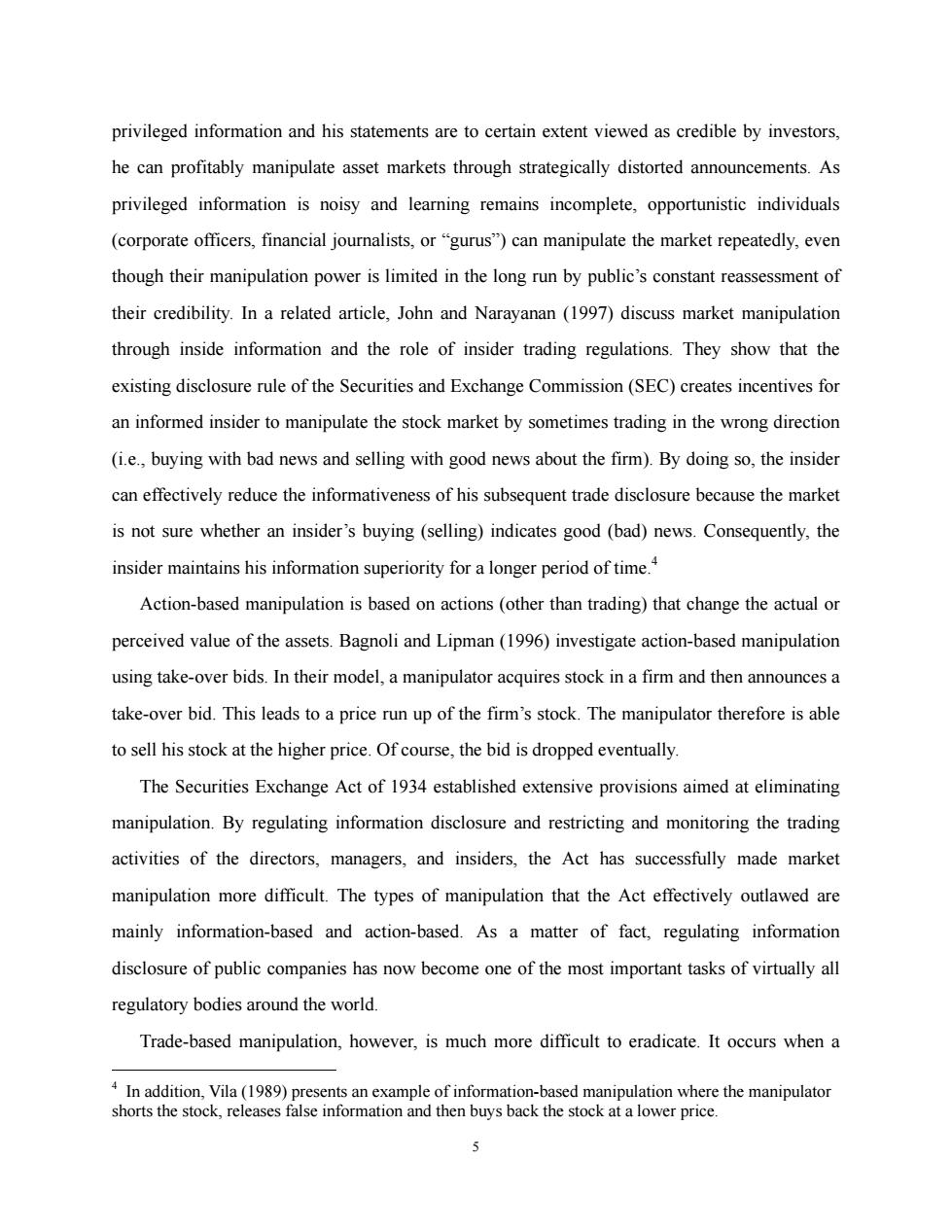
privileged information and his statements are to certain extent viewed as credible by investors, he can profitably manipulate asset markets through strategically distorted announcements.As privileged information is noisy and learning remains incomplete,opportunistic individuals (corporate officers,financial journalists,or "gurus")can manipulate the market repeatedly,even though their manipulation power is limited in the long run by public's constant reassessment of their credibility.In a related article,John and Narayanan (1997)discuss market manipulation through inside information and the role of insider trading regulations.They show that the existing disclosure rule of the Securities and Exchange Commission(SEC)creates incentives for an informed insider to manipulate the stock market by sometimes trading in the wrong direction (i.e.,buying with bad news and selling with good news about the firm).By doing so,the insider can effectively reduce the informativeness of his subsequent trade disclosure because the market is not sure whether an insider's buying (selling)indicates good (bad)news.Consequently,the insider maintains his information superiority for a longer period of time. Action-based manipulation is based on actions (other than trading)that change the actual or perceived value of the assets.Bagnoli and Lipman(1996)investigate action-based manipulation using take-over bids.In their model,a manipulator acquires stock in a firm and then announces a take-over bid.This leads to a price run up of the firm's stock.The manipulator therefore is able to sell his stock at the higher price.Of course,the bid is dropped eventually The Securities Exchange Act of 1934 established extensive provisions aimed at eliminating manipulation.By regulating information disclosure and restricting and monitoring the trading activities of the directors,managers,and insiders,the Act has successfully made market manipulation more difficult.The types of manipulation that the Act effectively outlawed are mainly information-based and action-based.As a matter of fact,regulating information disclosure of public companies has now become one of the most important tasks of virtually all regulatory bodies around the world. Trade-based manipulation,however,is much more difficult to eradicate.It occurs when a 4In addition,Vila(1989)presents an example of information-based manipulation where the manipulator shorts the stock,releases false information and then buys back the stock at a lower price. 5
5 privileged information and his statements are to certain extent viewed as credible by investors, he can profitably manipulate asset markets through strategically distorted announcements. As privileged information is noisy and learning remains incomplete, opportunistic individuals (corporate officers, financial journalists, or “gurus”) can manipulate the market repeatedly, even though their manipulation power is limited in the long run by public’s constant reassessment of their credibility. In a related article, John and Narayanan (1997) discuss market manipulation through inside information and the role of insider trading regulations. They show that the existing disclosure rule of the Securities and Exchange Commission (SEC) creates incentives for an informed insider to manipulate the stock market by sometimes trading in the wrong direction (i.e., buying with bad news and selling with good news about the firm). By doing so, the insider can effectively reduce the informativeness of his subsequent trade disclosure because the market is not sure whether an insider’s buying (selling) indicates good (bad) news. Consequently, the insider maintains his information superiority for a longer period of time.4 Action-based manipulation is based on actions (other than trading) that change the actual or perceived value of the assets. Bagnoli and Lipman (1996) investigate action-based manipulation using take-over bids. In their model, a manipulator acquires stock in a firm and then announces a take-over bid. This leads to a price run up of the firm’s stock. The manipulator therefore is able to sell his stock at the higher price. Of course, the bid is dropped eventually. The Securities Exchange Act of 1934 established extensive provisions aimed at eliminating manipulation. By regulating information disclosure and restricting and monitoring the trading activities of the directors, managers, and insiders, the Act has successfully made market manipulation more difficult. The types of manipulation that the Act effectively outlawed are mainly information-based and action-based. As a matter of fact, regulating information disclosure of public companies has now become one of the most important tasks of virtually all regulatory bodies around the world. Trade-based manipulation, however, is much more difficult to eradicate. It occurs when a 4 In addition, Vila (1989) presents an example of information-based manipulation where the manipulator shorts the stock, releases false information and then buys back the stock at a lower price
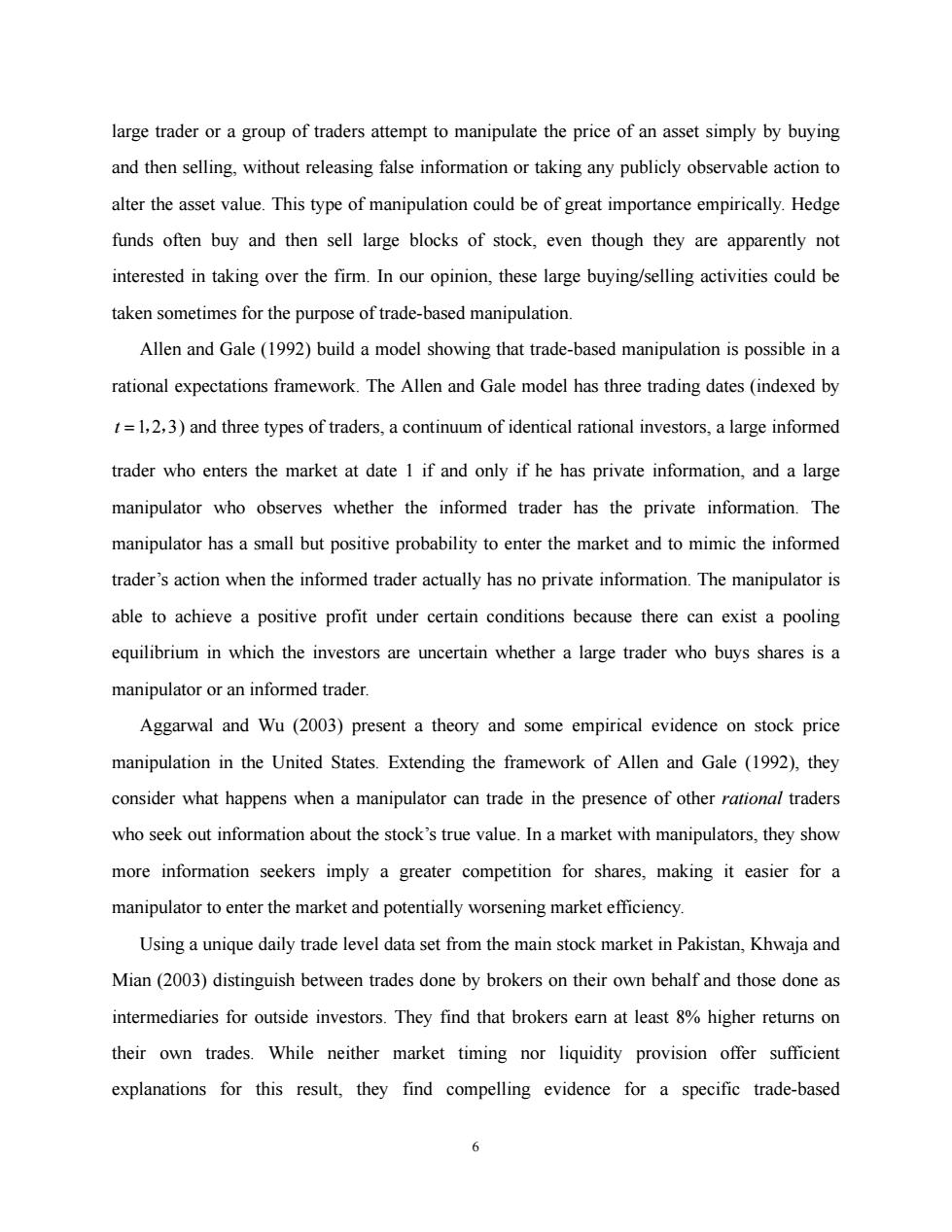
large trader or a group of traders attempt to manipulate the price of an asset simply by buying and then selling,without releasing false information or taking any publicly observable action to alter the asset value.This type of manipulation could be of great importance empirically.Hedge funds often buy and then sell large blocks of stock,even though they are apparently not interested in taking over the firm.In our opinion,these large buying/selling activities could be taken sometimes for the purpose of trade-based manipulation. Allen and Gale (1992)build a model showing that trade-based manipulation is possible in a rational expectations framework.The Allen and Gale model has three trading dates(indexed by t=1,2,3)and three types of traders,a continuum of identical rational investors,a large informed trader who enters the market at date 1 if and only if he has private information,and a large manipulator who observes whether the informed trader has the private information.The manipulator has a small but positive probability to enter the market and to mimic the informed trader's action when the informed trader actually has no private information.The manipulator is able to achieve a positive profit under certain conditions because there can exist a pooling equilibrium in which the investors are uncertain whether a large trader who buys shares is a manipulator or an informed trader. Aggarwal and Wu (2003)present a theory and some empirical evidence on stock price manipulation in the United States.Extending the framework of Allen and Gale (1992),they consider what happens when a manipulator can trade in the presence of other rational traders who seek out information about the stock's true value.In a market with manipulators,they show more information seekers imply a greater competition for shares,making it easier for a manipulator to enter the market and potentially worsening market efficiency. Using a unique daily trade level data set from the main stock market in Pakistan,Khwaja and Mian(2003)distinguish between trades done by brokers on their own behalf and those done as intermediaries for outside investors.They find that brokers earn at least 8%higher returns on their own trades.While neither market timing nor liquidity provision offer sufficient explanations for this result,they find compelling evidence for a specific trade-based 6
6 large trader or a group of traders attempt to manipulate the price of an asset simply by buying and then selling, without releasing false information or taking any publicly observable action to alter the asset value. This type of manipulation could be of great importance empirically. Hedge funds often buy and then sell large blocks of stock, even though they are apparently not interested in taking over the firm. In our opinion, these large buying/selling activities could be taken sometimes for the purpose of trade-based manipulation. Allen and Gale (1992) build a model showing that trade-based manipulation is possible in a rational expectations framework. The Allen and Gale model has three trading dates (indexed by t =1,2,3) and three types of traders, a continuum of identical rational investors, a large informed trader who enters the market at date 1 if and only if he has private information, and a large manipulator who observes whether the informed trader has the private information. The manipulator has a small but positive probability to enter the market and to mimic the informed trader’s action when the informed trader actually has no private information. The manipulator is able to achieve a positive profit under certain conditions because there can exist a pooling equilibrium in which the investors are uncertain whether a large trader who buys shares is a manipulator or an informed trader. Aggarwal and Wu (2003) present a theory and some empirical evidence on stock price manipulation in the United States. Extending the framework of Allen and Gale (1992), they consider what happens when a manipulator can trade in the presence of other rational traders who seek out information about the stock’s true value. In a market with manipulators, they show more information seekers imply a greater competition for shares, making it easier for a manipulator to enter the market and potentially worsening market efficiency. Using a unique daily trade level data set from the main stock market in Pakistan, Khwaja and Mian (2003) distinguish between trades done by brokers on their own behalf and those done as intermediaries for outside investors. They find that brokers earn at least 8% higher returns on their own trades. While neither market timing nor liquidity provision offer sufficient explanations for this result, they find compelling evidence for a specific trade-based
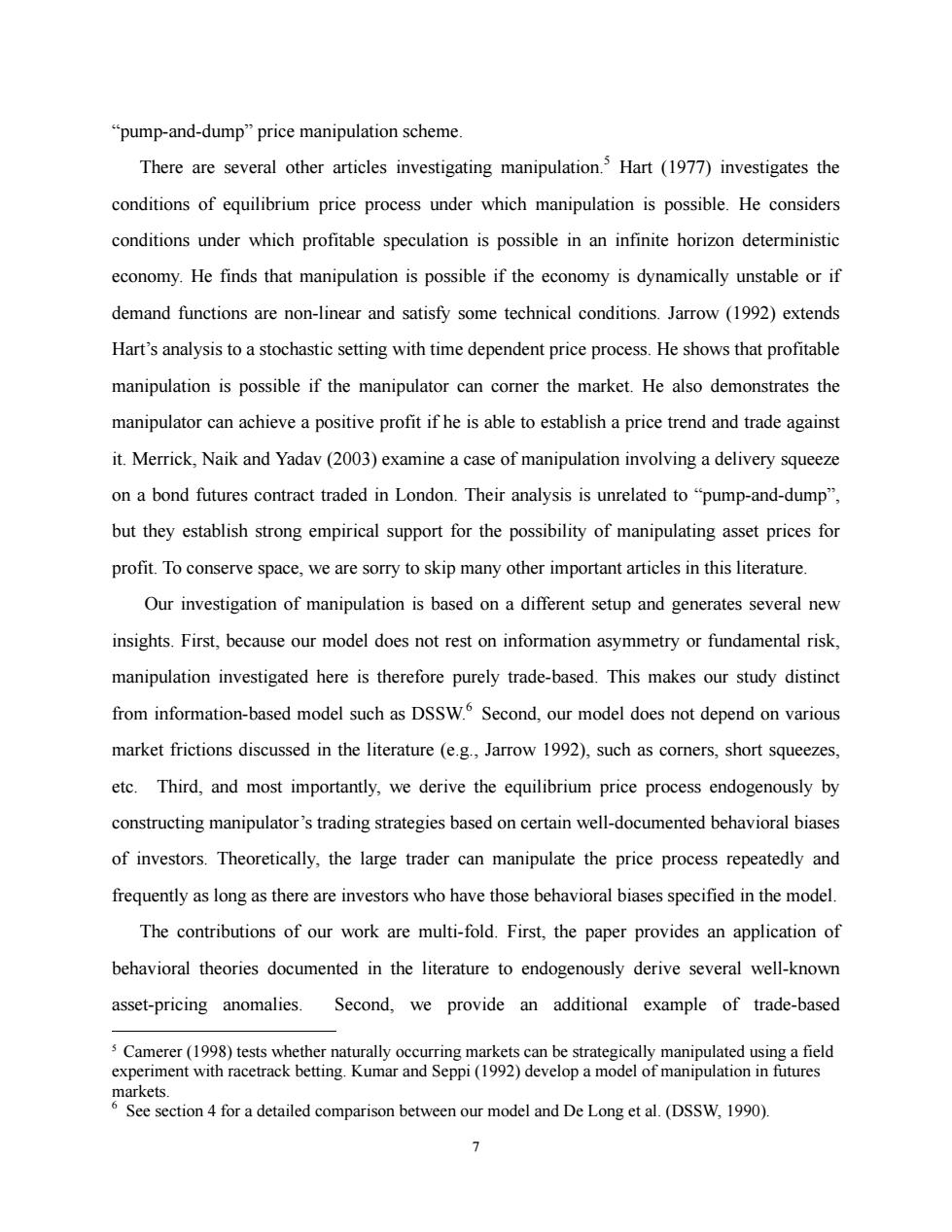
"pump-and-dump"price manipulation scheme. There are several other articles investigating manipulation.3 Hart (1977)investigates the conditions of equilibrium price process under which manipulation is possible.He considers conditions under which profitable speculation is possible in an infinite horizon deterministic economy.He finds that manipulation is possible if the economy is dynamically unstable or if demand functions are non-linear and satisfy some technical conditions.Jarrow (1992)extends Hart's analysis to a stochastic setting with time dependent price process.He shows that profitable manipulation is possible if the manipulator can corner the market.He also demonstrates the manipulator can achieve a positive profit if he is able to establish a price trend and trade against it.Merrick,Naik and Yadav(2003)examine a case of manipulation involving a delivery squeeze on a bond futures contract traded in London.Their analysis is unrelated to "pump-and-dump", but they establish strong empirical support for the possibility of manipulating asset prices for profit.To conserve space,we are sorry to skip many other important articles in this literature. Our investigation of manipulation is based on a different setup and generates several new insights.First,because our model does not rest on information asymmetry or fundamental risk, manipulation investigated here is therefore purely trade-based.This makes our study distinct from information-based model such as DSSW.Second,our model does not depend on various market frictions discussed in the literature (e.g.,Jarrow 1992),such as corners,short squeezes, etc.Third,and most importantly,we derive the equilibrium price process endogenously by constructing manipulator's trading strategies based on certain well-documented behavioral biases of investors.Theoretically,the large trader can manipulate the price process repeatedly and frequently as long as there are investors who have those behavioral biases specified in the model. The contributions of our work are multi-fold.First,the paper provides an application of behavioral theories documented in the literature to endogenously derive several well-known asset-pricing anomalies.Second,we provide an additional example of trade-based 5 Camerer(1998)tests whether naturally occurring markets can be strategically manipulated using a field experiment with racetrack betting.Kumar and Seppi(1992)develop a model of manipulation in futures markets. 6 See section 4 for a detailed comparison between our model and De Long et al.(DSSW,1990). >
7 “pump-and-dump” price manipulation scheme. There are several other articles investigating manipulation.5 Hart (1977) investigates the conditions of equilibrium price process under which manipulation is possible. He considers conditions under which profitable speculation is possible in an infinite horizon deterministic economy. He finds that manipulation is possible if the economy is dynamically unstable or if demand functions are non-linear and satisfy some technical conditions. Jarrow (1992) extends Hart’s analysis to a stochastic setting with time dependent price process. He shows that profitable manipulation is possible if the manipulator can corner the market. He also demonstrates the manipulator can achieve a positive profit if he is able to establish a price trend and trade against it. Merrick, Naik and Yadav (2003) examine a case of manipulation involving a delivery squeeze on a bond futures contract traded in London. Their analysis is unrelated to “pump-and-dump”, but they establish strong empirical support for the possibility of manipulating asset prices for profit. To conserve space, we are sorry to skip many other important articles in this literature. Our investigation of manipulation is based on a different setup and generates several new insights. First, because our model does not rest on information asymmetry or fundamental risk, manipulation investigated here is therefore purely trade-based. This makes our study distinct from information-based model such as DSSW.6 Second, our model does not depend on various market frictions discussed in the literature (e.g., Jarrow 1992), such as corners, short squeezes, etc. Third, and most importantly, we derive the equilibrium price process endogenously by constructing manipulator’s trading strategies based on certain well-documented behavioral biases of investors. Theoretically, the large trader can manipulate the price process repeatedly and frequently as long as there are investors who have those behavioral biases specified in the model. The contributions of our work are multi-fold. First, the paper provides an application of behavioral theories documented in the literature to endogenously derive several well-known asset-pricing anomalies. Second, we provide an additional example of trade-based 5 Camerer (1998) tests whether naturally occurring markets can be strategically manipulated using a field experiment with racetrack betting. Kumar and Seppi (1992) develop a model of manipulation in futures markets. 6 See section 4 for a detailed comparison between our model and De Long et al. (DSSW, 1990)

manipulation,distinct from the model of Allen and Gale (1992)--that does not impose assumptions on information asymmetry or the probability of manipulation.Third,we demonstrate a possibility of trade-based manipulation based on realistic assumptions about behavior that have been well documented empirically.One may view our paper as a companion paper of Allen and Gale.They study the possibility of price manipulation under rational expectations with information asymmetry while we provide a case of market manipulation under behavioral bias and limits to arbitrage but with no fundamental risk or information asymmetry. 2.The Model Economy We consider a discrete-time market in which there exist a speculative asset and a riskfree bond.The riskfree bond yields a zero net return each period of time.There are three classes of investors,a manipulator,arbitrageurs,and behavior-driven traders,who buy and sell the speculative asset following their own rules.The characteristics of these investors are described in detail in the following assumptions. Assumption 1.We consider a discrete-time economy that begins at time t=0,and ends at time t=T (namely,t=0,1,2,...,T).A continuum number of new behavior-driven investors,with measure 1,enter the market at the beginning of each period t.They are price-takers and each of them has a probability of q to buy a share of the speculative asset if the price of the asset at time t>0.P,is greater than the asset price at time t-1.P.If P.<P,each new behavior-driven investor has a probability of q2 to buy a share of the speculative asset. At the beginning of the economy,t=0,the price of the speculative asset (P)is equal to the fundamental value of the asset,and the behavior-driven investors are endowed with q shares of the speculative asset in total.Those investors who own the speculative asset at the beginning
8 manipulation, distinct from the model of Allen and Gale (1992)--that does not impose assumptions on information asymmetry or the probability of manipulation. Third, we demonstrate a possibility of trade-based manipulation based on realistic assumptions about behavior that have been well documented empirically. One may view our paper as a companion paper of Allen and Gale. They study the possibility of price manipulation under rational expectations with information asymmetry while we provide a case of market manipulation under behavioral bias and limits to arbitrage but with no fundamental risk or information asymmetry. 2. The Model Economy We consider a discrete-time market in which there exist a speculative asset and a riskfree bond. The riskfree bond yields a zero net return each period of time. There are three classes of investors, a manipulator, arbitrageurs, and behavior-driven traders, who buy and sell the speculative asset following their own rules. The characteristics of these investors are described in detail in the following assumptions. Assumption 1. We consider a discrete-time economy that begins at time t and ends at time = 0, t = T (namely, t T = 0,1,2,..., ). A continuum number of new behavior-driven investors, with measure 1, enter the market at the beginning of each period t. They are price-takers and each of them has a probability of 1 q to buy a share of the speculative asset if the price of the asset at time t>0, P , is greater than the a t sset price at time t-1, P . If t−1 P , each new t ≤ Pt−1 behavior-driven investor has a probability of 2 q to buy a share of the speculative asset. At the beginning of the economy, t = 0, the price of the speculative asset ( P ) is equal to the 0 fundamental value of the asset, and the behavior-driven investors are endowed with 1 q shares of the speculative asset in total. Those investors who own the speculative asset at the beginning
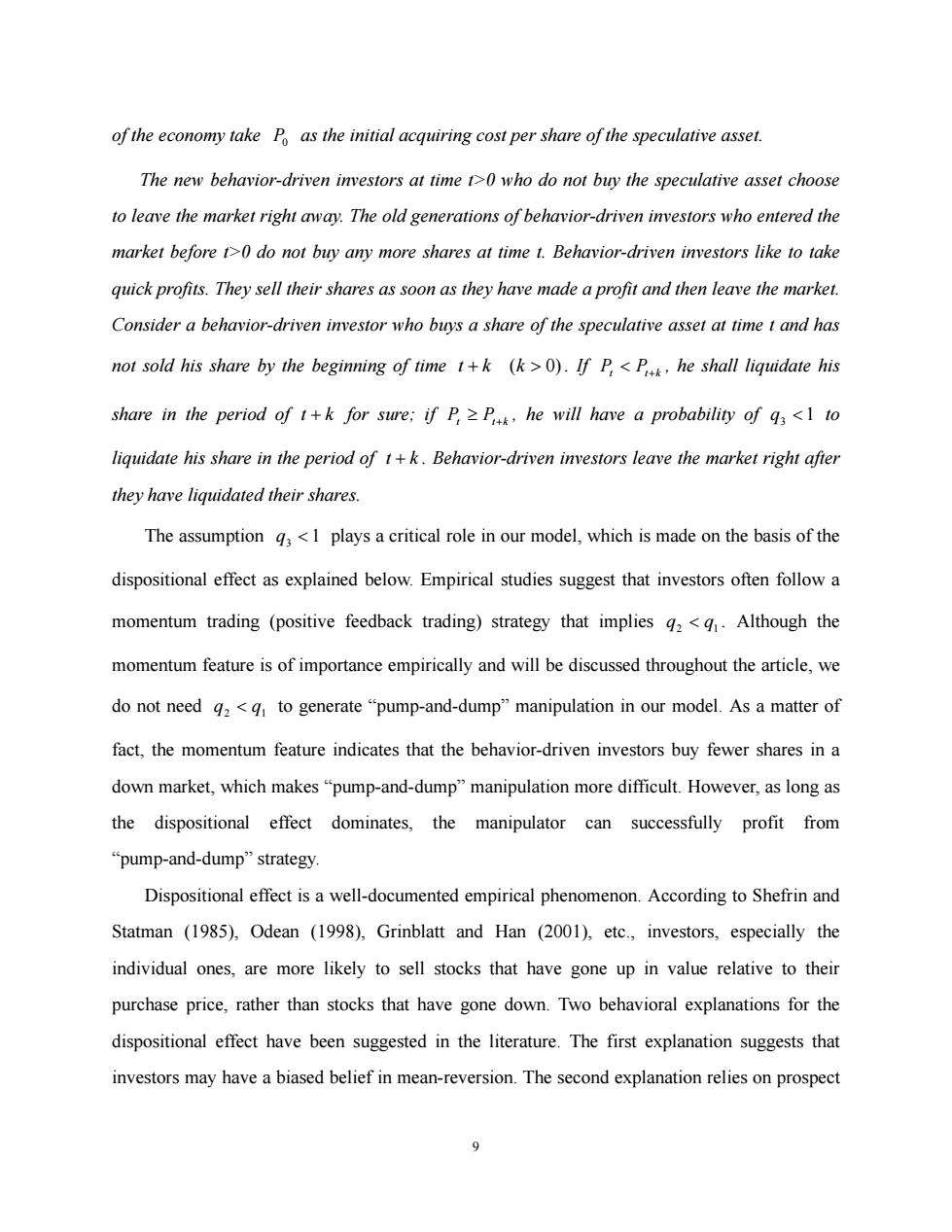
of the economy take P as the initial acquiring cost per share of the speculative asset. The new behavior-driven investors at time t>0 who do not buy the speculative asset choose to leave the market right away.The old generations of behavior-driven investors who entered the market before t>0 do not buy any more shares at time t.Behavior-driven investors like to take quick profits.They sell their shares as soon as they have made a profit and then leave the market. Consider a behavior-driven investor who buys a share of the speculative asset at time t and has not sold his share by the beginning of time t+k (k>0).If P<P he shall liquidate his share in the period of t+k for sure:if P.z P he will have a probability of q3 <1 to liquidate his share in the period of t+k.Behavior-driven investors leave the market right after they have liquidated their shares. The assumption 3<1 plays a critical role in our model,which is made on the basis of the dispositional effect as explained below.Empirical studies suggest that investors often follow a momentum trading (positive feedback trading)strategy that implies q2<g.Although the momentum feature is of importance empirically and will be discussed throughout the article,we do not need q2<q to generate"pump-and-dump"manipulation in our model.As a matter of fact,the momentum feature indicates that the behavior-driven investors buy fewer shares in a down market,which makes"pump-and-dump"manipulation more difficult.However,as long as the dispositional effect dominates,the manipulator can successfully profit from “pump-and-dump”strategy. Dispositional effect is a well-documented empirical phenomenon.According to Shefrin and Statman (1985),Odean (1998),Grinblatt and Han (2001),etc.,investors,especially the individual ones,are more likely to sell stocks that have gone up in value relative to their purchase price,rather than stocks that have gone down.Two behavioral explanations for the dispositional effect have been suggested in the literature.The first explanation suggests that investors may have a biased belief in mean-reversion.The second explanation relies on prospect 9
9 of the economy take P as the initial acquiring cost per share of the speculative asset. 0 The new behavior-driven investors at time t>0 who do not buy the speculative asset choose to leave the market right away. The old generations of behavior-driven investors who entered the market before t>0 do not buy any more shares at time t. Behavior-driven investors like to take quick profits. They sell their shares as soon as they have made a profit and then leave the market. Consider a behavior-driven investor who buys a share of the speculative asset at time t and has not sold his share by the beginning of time t + k (k > 0) . If Pt < Pt+k , he shall liquidate his share in the period of t + k for sure; if Pt ≥ Pt+k , he will have a probability of q to 3 < 1 liquidate his share in the period of t + k . Behavior-driven investors leave the market right after they have liquidated their shares. The assumption 1 q3 < plays a critical role in our model, which is made on the basis of the dispositional effect as explained below. Empirical studies suggest that investors often follow a momentum trading (positive feedback trading) strategy that implies 2 1 q < q . Although the momentum feature is of importance empirically and will be discussed throughout the article, we do not need 2 1 q < q to generate “pump-and-dump” manipulation in our model. As a matter of fact, the momentum feature indicates that the behavior-driven investors buy fewer shares in a down market, which makes “pump-and-dump” manipulation more difficult. However, as long as the dispositional effect dominates, the manipulator can successfully profit from “pump-and-dump” strategy. Dispositional effect is a well-documented empirical phenomenon. According to Shefrin and Statman (1985), Odean (1998), Grinblatt and Han (2001), etc., investors, especially the individual ones, are more likely to sell stocks that have gone up in value relative to their purchase price, rather than stocks that have gone down. Two behavioral explanations for the dispositional effect have been suggested in the literature. The first explanation suggests that investors may have a biased belief in mean-reversion. The second explanation relies on prospect